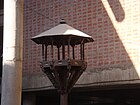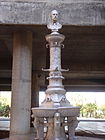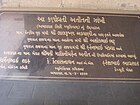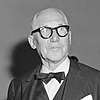
Charles-Édouard Jeanneret, known as Le Corbusier, was a Swiss-French architect, designer, painter, urban planner, writer, and one of the pioneers of what is now regarded as modern architecture. He was born in Switzerland and became a French citizen in 1930. His career spanned five decades, and he designed buildings in Europe, Japan, India, and North and South America.

The Unité d'habitation is a modernist residential housing typology developed by Le Corbusier, with the collaboration of painter-architect Nadir Afonso. It formed the basis of several housing developments throughout Europe designed by Le Corbusier and sharing the same name.

Balkrishna Vithaldas Doshi OAL was an Indian architect. He is an important figure in Indian architecture and noted for his contributions to the evolution of architectural discourse in India. Having worked under Le Corbusier and Louis Kahn, he was a pioneer of modernist and brutalist architecture in India.
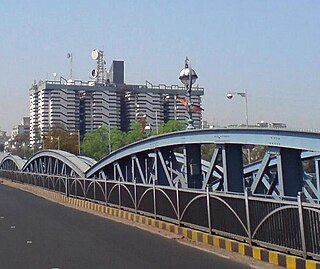
The Ellis Bridge is a century-old bridge in Ahmedabad, Gujarat. It bridges the western and eastern parts of the city across the Sabarmati river. This bowstring arch truss bridge was the first bridge in Ahmedabad, constructed in 1892. Concrete wings were added on either side in 1997 and it was renamed the Swami Vivekananda Bridge.

According to the 2011 national census, the population of Ahmedabad was declared to be 7,214,225. This figure was only limited to the municipality region. The total population of the Ahmedabad Urban Agglomeration came to 7.2 million people. There were 886 females to every 1000 males in 2001. Now there are 904 women to 1000 men in 2011. Ahmedabad had a literacy rate of 79.89% in 2001 which rose to 89.62 percent in 2011. Out of this, male and female literacy are 93.96 and 84.81 percent as of 2011 census. According to the census for the ninth plan, there are 30737 rural families living in Ahmedabad. Out of those, 5.41% live below the poverty line. There are 439,843 people who live in slums in the city. The majority of residents of Ahmedabad are native Gujaratis and speak Gujarati. There is also a sizable population of Punjabis, Marathis, Tamils, Sindhis, Malayalis and Marwaris who bring in their native language and culture to the city. The government institutions and military base near the city also bring peoples from across India. The city's population has increased in a major way following increasing economic expansion and modernization.
Paldi is an area located in South Western Ahmedabad, India. Corporate offices and city centres of many national and international companies like ICICI Bank, Royal Bank of Scotland, Religare, Claris, Gujarat Gas are located within Paldi. It accommodates Sanskar Kendra museum by the renowned architect Le Corbusier as well as Tagore Memorial Hall. The National Institute of Design is located in Paldi. M K Gandhi's first ashram in India, Kochrab Ashram is also located in Paldi. This area has many houses of the Art Deco period.

Béton brut is a French term that translates in English to “raw concrete”. The term is used to describe concrete that is left unfinished after being cast, displaying the patterns and seams imprinted on it by the formwork. Béton brut is not a material itself, but rather an architectural expression of concrete.

The National Museum of Western Art is the premier public art gallery in Japan specializing in art from the Western tradition.

Kunio Maekawa was a Japanese architect and a key figure in Japanese postwar modernism. His distinctive architectural language deftly blended together elements of traditional Japanese design and modernist tenets from Europe, drawing from early career work experiences in the offices of Le Corbusier and Antonin Raymond. He is especially known for the Tokyo Bunka Kaikan and the National Museum of Modern Art, Tokyo. His home, which he designed and completed in 1942, has been preserved and permanently installed in the Edo-Tokyo Open Air Architectural Museum.

Government Museum and Art Gallery, Chandigarh, is a premier museum of North India having collections of Gandharan sculptures, sculptures from ancient and medieval India, Pahari and Rajasthani miniature paintings. It owes its existence to the partition of India in August, 1947. Prior to the partition, much of the collections of art objects, paintings and sculptures present here were housed in the Central Museum, Lahore, the then capital of Punjab. The museum has one of the largest collection of Gandharan artefacts in the world.
Haku Vajubhai Shah was an Indian painter, Gandhian, cultural anthropologist and author on folk and tribal art and culture. His art belonged to the Baroda Group and his works are considered in the line of artists who brought themes of folk or tribal art to Indian art.

Junzo Sakakura was a Japanese architect and former president of the Architectural Association of Japan.

The Pavillon Le Corbusier is a Swiss art museum in Zürich-Seefeld at Zürichhorn dedicated to the work of the Swiss architect Le Corbusier. In 1960 Heidi Weber had the vision to establish a museum designed by Le Corbusier – this building should exhibit his works of art in an ideal environment created by the architect himself in the then Centre Le Corbusier or Heidi Weber Museum. In April 2014 the building and museum went over to the city of Zürich, and was renamed in May 2016.
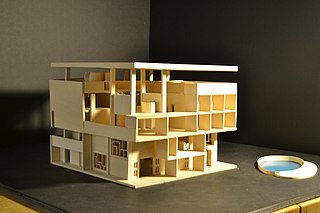
Villa Shodhan is a modernist villa located in Ahmedabad, India. Designed by the Swiss architect Le Corbusier, it was built between 1951 and 1956. Building on his previous projects whilst integrating the traditional features of Ahmedabad design, the villa symbolizes Le Corbusier's domestic architecture. The building is currently used as a private residence.
Le Corbusier's Five Points of Architecture is an architecture manifesto conceived by architect, Le Corbusier. It outlines five key principles of design that he considered to be the foundations of modern architectural discipline, which would be expressed though much of his designs.
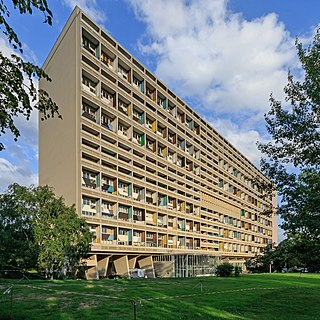
Unité d'Habitation of Berlin is a 1958 apartment building located in Berlin, Germany, designed by Le Corbusier following his concept of Unité d'Habitation. Le Corbusier's Unité d'Habitation concept was materialised in four other buildings in France with a similar design. The building is constructed in béton brut and is part of the initial architecture style we know today as brutalism. The structure was built with on site prefab cast concrete panels and poured ceiling slabs. The Modulor system is the base measure of the Unité and Corbusier used not more than 15 Modulor measures to construct the entire structure form. Ultimately the work has been eliminated from Le Corbusier's oeuvre, which he confirmed himself until his death in 1965 and which has also been confirmed posthumous in 1967 in his last authorized publication of his work.
The Architecture of Gujarat consists of architecture in the Indian state of Gujarat.

Gira Sarabhai was an Indian architect, designer, and a design pedagogue. She was born into the Sarabhai family and was the youngest of eight siblings. She is known for contributing to several industrial and educational projects in Gujarat. She was the representative of the Sarabhai Foundation, a public charitable trust. Gira, along with her brother Gautam Sarabhai were crucial in establishing and designing the academic curricula of National Institute of Design, Ahmedabad.
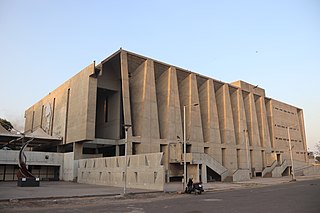
Tagore Memorial Hall, also known as Tagore Hall, is an auditorium in Ahmedabad, India. It is designed by B. V. Doshi in 1961. It is an example of brutalist architecture. Construction started in 1966 and was completed in 1971. It was renovated in 2013.








